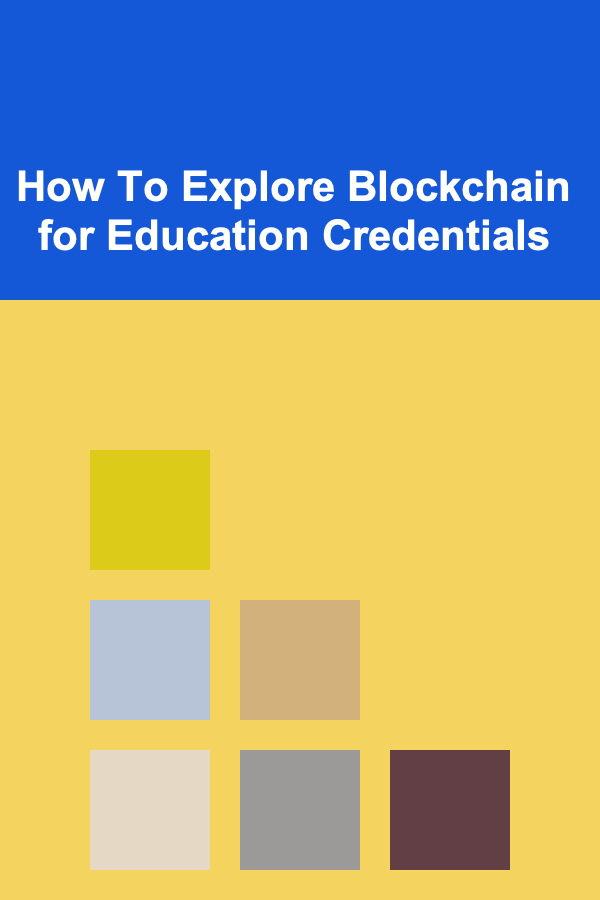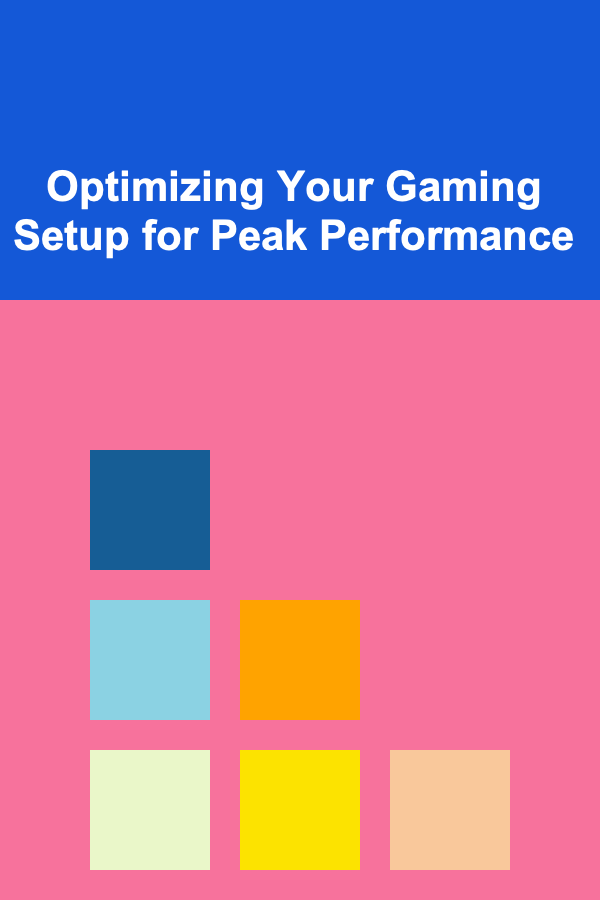
How To Explore Blockchain for Education Credentials
ebook include PDF & Audio bundle (Micro Guide)
$12.99$6.99
Limited Time Offer! Order within the next:

In recent years, the world has been embracing innovative technological advancements, with blockchain technology leading the charge in disrupting various industries. One area where blockchain holds great potential is the education sector. Traditional methods of managing educational credentials, such as transcripts, degrees, and certifications, have long been cumbersome and prone to fraud. As education becomes more globalized and digital, the need for a secure, transparent, and verifiable system for credential management is more critical than ever.
Blockchain technology, with its decentralized and immutable nature, promises to revolutionize how we store and validate educational credentials. By leveraging blockchain, educational institutions, employers, and students alike can benefit from a more efficient, secure, and trustworthy system. In this article, we will explore how blockchain can be applied to education credentials, its potential benefits, challenges, and how stakeholders can start exploring this emerging technology.
Understanding Blockchain Technology
Before delving into how blockchain can be used in the context of education credentials, it is essential to understand what blockchain is and how it works. At its core, blockchain is a distributed ledger technology (DLT) that allows data to be securely stored across multiple locations in a decentralized and tamper-proof manner. The data on a blockchain is organized into "blocks," which are linked together to form a "chain." Each block contains a list of transactions, along with a cryptographic hash of the previous block, creating a chain of information that is resistant to manipulation.
There are several key features of blockchain technology that make it suitable for educational credentialing:
- Decentralization: Unlike traditional centralized systems, blockchain is not controlled by a single entity. This makes it resistant to corruption or manipulation by any single party.
- Immutability: Once data is recorded on the blockchain, it cannot be altered or deleted. This ensures the integrity of the information, making it ideal for tracking and verifying educational achievements.
- Transparency: Blockchain offers transparency, as all transactions are visible to participants in the network, ensuring that anyone can verify the authenticity of the data.
- Security: Blockchain uses cryptography to secure transactions, ensuring that only authorized participants can add or modify information. This makes it highly secure against hacking and fraud.
Blockchain for Educational Credentials: The Problem with Traditional Systems
Traditional systems for managing educational credentials have several shortcomings:
1. Risk of Fraud and Forgery
One of the primary challenges in the current credentialing system is the risk of fraud. It is not uncommon for individuals to forge or manipulate academic transcripts, degrees, or certificates to gain employment or admission to educational institutions. This undermines the value of these credentials and causes institutions to invest considerable resources in verifying their authenticity.
2. Time-Consuming and Expensive Verification Process
The process of verifying educational credentials is often time-consuming and costly. Employers and educational institutions need to contact the issuing institution directly or rely on third-party verification services to confirm the authenticity of a diploma or degree. This not only delays hiring processes or admissions but also incurs additional costs.
3. Lack of Portability
In today's increasingly mobile world, individuals are often required to move between institutions, countries, and industries. However, transferring educational credentials from one institution to another or from one country to another can be a cumbersome process. This lack of portability makes it difficult for students and professionals to showcase their qualifications to potential employers or educational institutions across borders.
4. Inability to Track Lifelong Learning
As the demand for lifelong learning grows, individuals are expected to acquire new skills and certifications throughout their careers. Traditional credentialing systems often struggle to keep track of these ongoing educational achievements. Blockchain could address this challenge by providing a decentralized and verifiable record of all learning experiences, from formal degrees to online courses and certifications.
How Blockchain Can Transform Educational Credentialing
Blockchain can address the above challenges by providing a secure, transparent, and efficient system for managing educational credentials. Let's look at some of the ways blockchain can revolutionize the education credentialing process.
1. Immutable Digital Records
Using blockchain, educational institutions can issue immutable digital records of degrees, diplomas, certificates, and transcripts. Once issued, these records cannot be altered or forged. Students, employers, and institutions can easily verify the authenticity of these credentials by checking the blockchain ledger, reducing the risk of fraud and forgery.
2. Decentralized Verification
Blockchain's decentralized nature means that there is no need for a central authority to verify educational credentials. Instead, each participant in the network, such as educational institutions, employers, and students, can independently verify the credentials through the blockchain. This reduces the need for intermediaries and speeds up the verification process.
3. Increased Portability
Blockchain allows for the creation of universally recognized and portable digital credentials that can be shared and verified across borders. Students can carry their credentials with them throughout their educational journey and career, and employers can easily check their qualifications without relying on slow and costly verification processes.
4. Continuous Lifelong Learning Records
Blockchain allows for the creation of a continuous and up-to-date record of an individual's educational achievements. As students complete courses, certifications, and training programs, they can have these achievements recorded on the blockchain, creating a lifelong learning record. This helps individuals showcase their evolving skill sets, making it easier for employers and educational institutions to evaluate their qualifications.
5. Smart Contracts for Automation
Smart contracts are self-executing contracts with the terms of the agreement directly written into code. In the context of educational credentials, smart contracts could automate various processes, such as issuing certificates, verifying qualifications, or transferring credits between institutions. This automation could streamline the credentialing process, saving time and reducing administrative costs.
6. Increased Security and Privacy
Blockchain uses advanced cryptographic techniques to secure data. This ensures that educational records are protected from hacking or unauthorized access. Additionally, students have more control over their data, as they can decide who has access to their credentials and under what circumstances. This addresses concerns about data privacy and ensures that only authorized parties can view sensitive information.
Use Cases of Blockchain for Education Credentials
1. University Degrees and Diplomas
Several universities and educational institutions have already begun exploring blockchain for issuing digital degrees and diplomas. For example, the University of Melbourne has partnered with a blockchain company to issue blockchain-based degrees, enabling students to have verifiable and immutable records of their academic achievements.
2. Professional Certifications
Blockchain can also be used to issue professional certifications. Organizations like IBM and Microsoft have already implemented blockchain-based certification systems to validate their employees' skills and achievements. Blockchain can provide a secure and verifiable way to issue certifications in fields like IT, healthcare, and finance.
3. Online Learning Platforms
Blockchain can be particularly useful for online learning platforms like Coursera, edX, and Udacity. These platforms offer various courses and certifications, but there is often skepticism regarding the authenticity of these credentials. By leveraging blockchain, online learning platforms can issue verifiable certificates, helping students and employers trust the credentials earned through these courses.
4. Cross-Border Credential Recognition
Blockchain can make it easier for students to have their credentials recognized across borders. For example, students who complete their education in one country can have their credentials instantly verified by institutions or employers in another country. This can improve access to global job markets and educational opportunities, particularly in developing countries.
Challenges and Considerations
While blockchain holds great promise for transforming education credentialing, there are several challenges and considerations that need to be addressed.
1. Adoption and Standardization
One of the biggest challenges in adopting blockchain for educational credentials is ensuring widespread adoption. Educational institutions, employers, and governments must collaborate to establish common standards for blockchain-based credentials. Without a unified framework, the system could become fragmented, limiting its effectiveness.
2. Privacy Concerns
While blockchain offers increased security, privacy concerns remain. Blockchain's transparency feature means that anyone with access to the blockchain network can view the information. This raises concerns about the privacy of sensitive educational data, such as student grades or personal information. Implementing privacy-focused blockchain solutions, such as zero-knowledge proofs, could help address these concerns.
3. Technical Barriers
Implementing blockchain-based credentialing systems requires significant technical expertise and infrastructure. Educational institutions need to invest in developing the necessary blockchain infrastructure, and students must be educated on how to use and manage their blockchain-based credentials. Additionally, blockchain networks can sometimes be slow and costly, particularly when scaling to a large number of users.
4. Legal and Regulatory Issues
The legal and regulatory framework surrounding blockchain-based educational credentials is still evolving. Governments and educational bodies need to establish guidelines for the recognition and verification of blockchain credentials. Without proper regulations, blockchain-based credentials may not be universally accepted by employers or institutions.
Conclusion
Blockchain has the potential to transform the education sector by providing a more secure, transparent, and efficient system for managing educational credentials. From reducing fraud and improving verification processes to increasing portability and tracking lifelong learning, blockchain offers numerous benefits for students, educational institutions, and employers alike. While there are challenges to overcome, the benefits of blockchain-based credentialing systems make it a promising technology for the future of education.
As blockchain technology continues to evolve, it is important for educational institutions, policymakers, and technology providers to collaborate in creating standardized frameworks and solutions that will enable the widespread adoption of blockchain for education credentials. By doing so, we can create a more secure and efficient system that empowers individuals to showcase their skills and achievements in a global, digital world.

How to Manage Debt Effectively: Strategies for Success
Read More
How to Plan Your Week for Optimal Productivity
Read More
Must-Have Thrifty Baby and Toddler Essentials That Save You Money
Read More
Optimizing Your Gaming Setup for Peak Performance
Read More
How To Find Books That Offer Pure Escapism
Read More
How to Transition Your Budgie to a New Food
Read MoreOther Products

How to Manage Debt Effectively: Strategies for Success
Read More
How to Plan Your Week for Optimal Productivity
Read More
Must-Have Thrifty Baby and Toddler Essentials That Save You Money
Read More
Optimizing Your Gaming Setup for Peak Performance
Read More
How To Find Books That Offer Pure Escapism
Read More